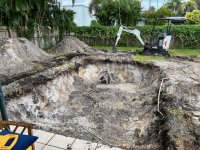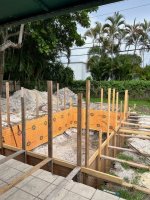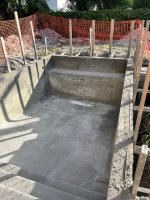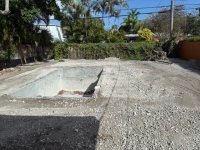As Matt (
@JoyfulNoise) states, there are tons of tips and explanations across hundreds of posts in those search results, all worth a careful read-through – or two (three?) read-throughs

In those many threads I’m not sure we ever summarized it well. So here goes: The supplied FPH controller does a few things. First it senses whether your HVAC is running by means of the 24VAC from the condenser unit contactor, as
@Maverick23 states. And of course the FPH controller also senses your pool temp. The FPH controller also has a heat temperature setting in a PID controller (it’s really just an elaborate thermometer with relay contacts). If your HVAC is running and the PID temp setting calls for pool heat, the FPH controller does a few more things: First , it sends it’s own source of 24VAC back to the condenser unit to turn off the cooling fan and switch the refrigerant path to bypass your HVAC air cooled condenser coils and condense refrigerant through the new FPH heat exchanger. Under those conditions, the FPH controller also activates a relay to send 220Vac to a standard single speed pool pump (could be 120 or 240V). There are at least three ways to modify the wiring to drive a VSP. If you don’t want to modify the FPH relay wiring, you could add another relay that closes a pair of dry contacts when it gets the 120v (or 240) from the FPH relay. Those dry contacts then tell the VSP to come on and I believe most or all VSP’s and automation systems offer the dry contact sensing. The 2nd way, what I did when I first added a VSP, is to modify the FPH relay so that instead of sending 220v to the pump, that rewired relay became the dry contact closure device, using only one pole of that FPH relay to do so. In the end however, I just ran my VSP 7x24 on a low speed. But, as I documented in later threads, the 24Vac sent back to the hvac system should first be wired through a pressure or flow switch, so that the refrigerant path only switches to the FPH heat exchanger when there is true water flow. Back when I implemented, FPH ignored flow which leaves you vulnerable to AC failure (compressor overheat/overpressure) if the pump fails to start, which in my experience VSP’s are prone to do. But all pumps fail at some point, so logic is needed to keep the hvac from switching to FPH if flow is not happening. They also sell inexpensive delay modules that might also be a good addition to that flow path, so that the pump has time to prime and fully create flow before switching the refrigerant path.
It's not rocket science but it is nontrivial, best handled by an electrician and/or pool pump person with similar knowledge or experience, at least for the pool/pump interfaces. More difficult is the installation of the sporlan refrigerant valve and check valve(s) that are brazed in place to reroute refrigerant. That requires an epa608 certified hvac tech to remove/recover current refrigerant, install the sporlan valve and, as necessary refrigerant check valve(s), then re-charge refrigerant and test all functionality. For some of us, finding an HVAC tech willing to do that work can be the toughest part (think of a tech familiar with “heat recovery” systems). When found, that tech will want to work hourly and they likely will need to speak with FPH experts about check valve dependencies and such, depending on your hvac design. Back when I did it, I learned enough to be the go-between interface between FPH techs and local HVAC tech – and I had a very good hvac tech. Somewhere in all those posts I included what it cost me for all that, including tech labor.
I think most of us got all that worked out
before buying the FPH, but I applaud your gumption if you just dove in!










